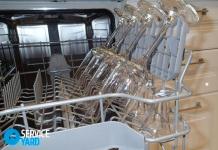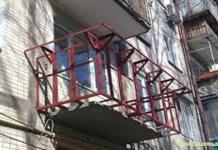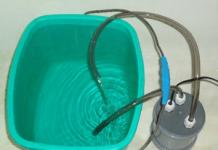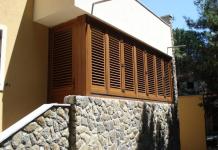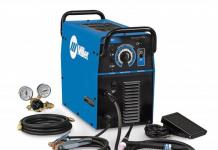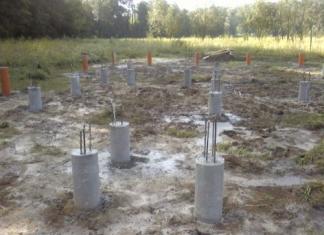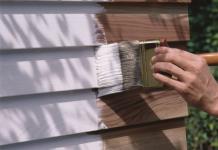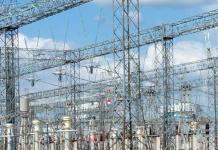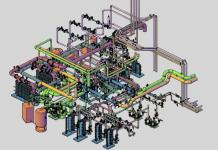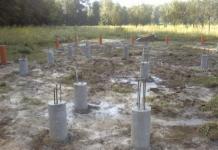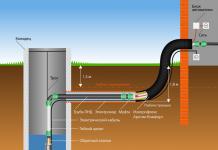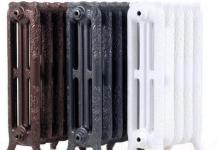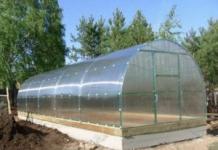Please note that in the pump connection diagram there must be either a differential circuit breaker (as in our diagram) or a combination of a protective circuit breaker and an RCD (Residual Current Device). This is required, first of all, to protect a person from electric shock, in the event of a pump malfunction or incorrect connection.
As you can see, there is nothing complicated in the circuit; for operation, a household circulation pump requires a phase and zero (working zero), and besides, an indispensable safety element is grounding (protective zero). Therefore, in the terminal box of the pump there are three contacts, with the corresponding marking.
Detailed photo instructions for connecting the circulation pump to the mains, according to this scheme - HERE (link will open in a new window).
Most circulation pumps in heating systems are connected according to this standard scheme. The main disadvantage of which is that the pumps have to be turned on and off manually each time, so they are often turned on at the beginning of the heating season and turned off at the end. The disadvantages of this method of connection, I think, are obvious, the extra power consumption and a decrease in the life of the pump.
To automate the operation of the circulation pump in the heating system, in order to reduce energy costs and increase the overall life of the pump, you can connect it through a thermostat.
At the same time, the temperature of the coolant is measured by the thermostat and, if it is low, the circulation pump does not turn on so as not to drive cold water through the system in vain (or another coolant), and when the temperature of the coolant at the boiler reaches the required level, the pump starts.
The connection diagram of the circulation pump through the thermostat is as follows
The heating system itself in the diagram is primitive, presented for a general understanding of the operation of the thermostat, but it can be seen from it that a pipe thermostat is installed on the heating pipe, near the boiler, which measures the temperature of the pipe, and, depending on it, turns on or off the circulation pump.
Also, if you do not find a special pipe thermostat (as in the diagram), you can use a regular room thermostat with an external temperature sensor that is mounted on the pipe.
Other schemes for connecting the circulation pump through a thermostat, for example, to control the temperature in the room, most often cannot be used.
And although it seems logical to turn off the circulation of hot water (or other coolant) when the room gets too hot and turn it on when it's cold, this approach is wrong.
In this case, the thermostat should control the boiler, turning it on and off if necessary, and not the pumps that drive the coolant through the system.
Scheme of connecting the circulation pump through an uninterruptible power supply (UPS)
Another important task in creating a home heating system is to ensure its maximum autonomy and overall reliability.
For non-volatile heating systems, the heart of which is gas or solid fuel boilers that consume little electricity, such a solution lies in the implementation of the circuit for connecting circulation pumps through uninterruptible power supplies.
At the same time, the autonomy of the system increases many times over. Familiar to many power outages in the private sector, which unfortunately happen on the coldest, darkest nights and lead to freezing and often destruction of both the heating system and the whole house, now you are practically not afraid.
Preparing to install a heating pump
Before installing the pump, you need to buy it. A lot depends on the right choice.
Pumping equipment can be of different types.
There are many different models on the market from different manufacturers. It is necessary to choose a pump for heating, the characteristics of which correspond to the characteristics of the room, its area, the number of windows, external walls, etc. It is better to give preference to a more well-known manufacturer. Too cheap units should not be bought in view of the high probability of acquiring a fake. And when using such equipment, many problems can arise.
To simplify the process of installing a pump for heating, it is better to choose a pumping device with split threads. Otherwise, you will need to select adapters. And not every user will like it.
From additional equipment and tools for work you will need:
- check valve. Without it, the operation of the pressure pump will be inferior;
- deep cleaning filter;
- stop valves;
- bypass from a pipe section. The diameter must match the diameter of the riser;
- special keys for installation.
- - sealant;
- - rubber or silicone gaskets;
- - a set of keys from "22" to "36".
Choose a pump for space heating, taking into account its heat loss. The calculation should include the heat losses of the outer walls, the thermal regime, i.e. what will be the average temperature in the building, the area of \u200b\u200bthe room and other parameters. According to the theory, "the heat flow depends on the heat loss on the external fences, which are directly proportional to the difference between the outdoor temperature T1 and the temperature T inside the room, the area S of the heated room, the heat loss coefficient (W/m² K)". This calculation can be represented as follows:
With a radiator heating system, if the area (S) of the room is 80-120 m², then the pump should produce a coolant of 0.4 m³ per hour, at 120-160 m² - 0.5 m³;
With the "warm floor" system, if S = 80-120 m² - 1.5 m³, with 120-160 m² - 2.0 m³.
Install the pump in a heating system with radiators on the return line near the boiler, where the temperature is lowest. In apartments and houses with an area of up to 200 m², this is rather arbitrary, since the coolant differs from the supply on the return pipe by 1-2 degrees. Therefore, in heating systems of small circuits, it does not matter where the pump is installed. The installation of the circulation pump for heating is carried out at the time of installation of the heating system, if it is operating, then the coolant must first be drained. You can not do this if taps are installed on the incoming and outgoing pipelines that block access to it. Then you should close them and start the installation.
Install it in the direction indicated by the arrow on the case. It means the movement of the coolant. Before entering the pump, a cleaning filter should be installed. Protect each threaded connection with sealant and a gasket between mating parts. The pump must be installed strictly horizontally, otherwise the rotor may be damaged, and its constant “roar” will be heard. After installing and filling it with coolant, open the central screw located on the top cover. Some liquid will come out of the hole. This will remove excess air from the pump. It can be connected to a 220V network or using a conventional electrical plug, or through an electrical machine.
Install a pump in the supply line in the underfloor heating system. This will prevent any possibility of a flow break and air entering the system. The formation of air congestion is the biggest nuisance in underfloor heating.
How to connect the circulation pump to electricity
The circulation pump is an important element of modern heating systems. It is needed for forced circulation of water in the heating system, which allows you to save up to 30% on heating private houses and cottages.
The savings lies in the fact that the coolant quickly passes through the pipes, as a result of which the water does not cool down so quickly and, accordingly, there is no need to heat it up much. This article will discuss the correct connection of the circulation pump to the mains.
Diagrams and video instructions will help you to carry out wiring without errors!
What is important to know?
The wiring diagram and methods of connecting a device such as a circulation pump to electricity can have different versions. The choice of a particular option is determined by the characteristics of the heated object, as well as the place where the device is located. There are two possibilities to connect it:
- direct connection to the mains 220 V;
- connection to an uninterruptible power supply, which, in turn, is connected to a 220 V or 220/380 V network (in the case of a three-phase UPS).
Choosing the first method, the consumer runs the risk of being left without heating in the event of a long power outage. This option can be considered justified only with a high degree of power supply reliability, which reduces the likelihood of a long power outage to a minimum, and also if there is a backup source of electrical energy at the facility. The second method is preferable, although it requires additional costs.
Power connection
Circulation pumps operate from a 220 V network. Connection - standard, a separate power line with a circuit breaker is desirable. Three wires are required for connection - phase, zero and ground.
Electrical connection diagram of the circulation pump
The connection to the network itself can be organized using a three-pin socket and plug. This connection method is used if the pump comes with a connected power cable. It can also be connected via a terminal block or directly with a cable to the terminals.
The terminals are located under a plastic cover. We remove it by unscrewing a few bolts, we find three connectors. They are usually signed (pictograms are applied N - neutral wire, L - phase, and "earth" has an international designation), it is difficult to make a mistake.
Where to connect the power cable
Since the entire system depends on the performance of the circulation pump, it makes sense to make a backup power supply - put a stabilizer with connected batteries. With such a power supply system, everything will work for several days, since the pump itself and the boiler automation “pull” electricity to a maximum of 250-300 watts. But when organizing, you need to calculate everything and select the capacity of the batteries. The disadvantage of such a system is the need to ensure that the batteries are not discharged.
How to connect a circulator to electricity through a stabilizer
Hello. My situation is that a 25 x 60 pump stands right after the 6 kW electric boiler, then the line from the 40 mm pipe goes to the bathhouse (there are three steel radiators) and returns to the boiler; after the pump, the branch goes up, then 4 m, down, rings the house of 50 sq. m. through the kitchen, then through the bedroom, where it doubles, then the hall, where it triples and flows into the boiler return; in the bath branch 40 mm up, leaves the bath, enters the 2nd floor of the house 40 sq. m. (there are two cast-iron radiators) and returns to the bath in the return line; the heat did not go to the second floor; the idea to install a second pump in the bath for supply after a branch; the total length of the pipeline is 125 m. How correct is the solution?
The idea is correct - the route is too long for one pump.
The most economical and convenient option for underfloor heating - water floors with connection to boiler. Such a system allows you to save a large amount of electricity and makes it possible to independently regulate the heating temperature. In addition, it is easier to install.
- - wall-mounted boiler for underfloor heating;
- - manifold cabinet;
- - shut-off valves;
- - compression fittings;
- - circulation pump;
- - thermostat (preferably, but not required).
Install underfloor heating in a sand-cement screed. To do this, prepare all the components of the system. Remove the existing screed and distribute all the underfloor heating elements over the area where they are planned to be installed.
Then hang the boiler for underfloor heating in a convenient place - so that the water pipe loops come from the collector. If you install floors in your own home, then it is advisable to place the equipment in a specially designated room. Regarding the installation of the boiler in the apartment, it is better to consult with an experienced master.
Install the manifold cabinet. Its task is to carry out the circulation of water in pipes and to combine floor heating with other domestic heating.
Lead the supply and return pipes into the installed manifold cabinet. The first will supply hot water to the water floors. the second is to take the cooled liquid and return it back to the boiler. Install a shut-off valve on each pipe so that you can turn off the water if necessary.
Using a compression fitting, connect the pipe from the boiler to a metal valve, and connect the manifold inlet to the valve. Fittings connect the contours of the warm floor to the collector.
In the collector, install a circulation pump designed for continuous water circulation. It is mounted on the supply pipe. It is better to purchase a pump with a thermostat. which will allow you to control the temperature of the floor heating.
After that, turn on the system, check its operation.
The final installation of underfloor heating is carried out only after the operation of the heating system has been checked. It should function for at least 10-12 hours. And, if everything is in order, the floor surface is laid above the pipes. Otherwise, there is a risk of flooding your own house due to a minor mistake. If the pipes are laid in a sand-cement screed, the system can only be turned on after the solution has completely hardened.
To avoid problems with connecting a variety of various control devices, you can purchase a pump mixing circuit for wall-mounted boilers, which includes a circulation pump and almost the entire set of equipment.
- Installation of a water heated floor
- how to connect underfloor heating
Installation of Vilo pumps
Today, Vilo pumps are very popular on the market. They have good technical characteristics. A wide variety of sizes of threaded and flanged connections allows you to choose just such pumping equipment, which is ideal for installation in an existing heating system. And the heating radiator itself will not be involved in the work.
It is worth considering how to connect the Vilo heating pump. Installation of vilo units is not difficult. The Wilo pump can be installed directly on the pipeline. There are different models. If the room has a small area (up to 750 sq.m), then the Wilo-Star-RS model should be preferred. The pumps of this series are equipped with three-stage switches. For power, you need a current with a voltage of 230 volts. The device can operate at a temperature of the working fluid from -10 to +110 degrees. In this case, the ambient temperature should not exceed +40 degrees.
The installation of this unit involves the horizontal placement of its shaft. The terminal box has two cable outlets. Therefore, the Wilo heating pump can be connected to the mains from any side. Thanks to the spring-loaded terminals, cable connection is very easy.
Thus, connecting a pump for heating is not a difficult job. And you can do it yourself. The main thing is to correctly select pumping equipment, know the installation features and follow a number of rules during the installation of the device.
What is a circulation pump and why is it needed
A circulation pump is a device that changes the speed of movement of a liquid medium without changing the pressure. In heating systems, it is placed for more efficient heating. In systems with forced circulation, it is an indispensable element; in gravitational systems, it can be installed if it is necessary to increase the thermal power. Installing a circulation pump with several speeds makes it possible to change the amount of heat transferred depending on the temperature outside, thus maintaining a stable temperature in the room.
Sectional view of a wet rotor circulation pump
There are two types of such units - with a dry and wet rotor. Devices with a dry rotor have a high efficiency (about 80%), but they are very noisy and require regular maintenance. Wet rotor units operate almost silently, with a normal quality of the coolant, they can pump water without failures for more than 10 years. They have a lower efficiency (about 50%), but their characteristics are more than enough to heat any private house.
Circulation pumps are installed in heating systems with forced or natural circulation. It is needed to increase heat transfer and to be able to adjust the temperature in the room. Installing a circulation pump is not the most difficult task; if you have a minimum of skills, you can do it yourself, with your own hands.
What is a circulation pump and why is it needed
A circulation pump is a device that changes the speed of movement of a liquid medium without changing the pressure. In heating systems, it is placed for more efficient heating. In systems with forced circulation, it is an indispensable element; in gravitational systems, it can be installed if it is necessary to increase the thermal power. Installing a circulation pump with several speeds makes it possible to change the amount of heat transferred depending on the temperature outside, thus maintaining a stable temperature in the room.
Sectional view of a wet rotor circulation pump
There are two types of such units - with a dry and wet rotor. Devices with a dry rotor have a high efficiency (about 80%), but they are very noisy and require regular maintenance. Wet rotor units operate almost silently, with a normal quality of the coolant, they can pump water without failures for more than 10 years. They have a lower efficiency (about 50%), but their characteristics are more than enough to heat any private house.
Where to put
It is recommended to install a circulation pump after the boiler, before the first branch, but it does not matter on the supply or return pipeline. Modern units are made from materials that normally tolerate temperatures up to 100-115 ° C. There are few heating systems that work with a hotter coolant, therefore considerations of a more “comfortable” temperature are untenable, but if you are so calmer, put it in the return line.

Can be installed in the return or direct pipeline after/before the boiler up to the first branch
There is no difference in hydraulics - the boiler, and the rest of the system, it does not matter whether there is a pump in the supply or return branch. What matters is the correct installation, in terms of tying, and the correct orientation of the rotor in space. Nothing else matters.
There is one important point at the installation site. If there are two separate branches in the heating system - on the right and left wings of the house or on the first and second floors - it makes sense to put a separate unit on each, and not one common one - directly after the boiler. Moreover, the same rule is preserved on these branches: immediately after the boiler, before the first branching in this heating circuit. This will make it possible to set the required thermal regime in each of the parts of the house independently of the other, and also in two-story houses to save on heating. How? Due to the fact that the second floor is usually much warmer than the first floor and much less heat is required there. If there are two pumps in the branch that goes up, the speed of the coolant is set much less, and this allows you to burn less fuel, and without compromising the comfort of living.
There are two types of heating systems - with forced and natural circulation. Systems with forced circulation cannot work without a pump, with natural circulation they work, but in this mode they have a lower heat transfer. However, less heat is still much better than no heat at all, so in areas where electricity is often cut off, the system is designed as hydraulic (with natural circulation), and then a pump is slammed into it. This gives high efficiency and reliability of heating. It is clear that the installation of a circulation pump in these systems has differences.

All heating systems with underfloor heating are forced - without a pump, the coolant will not pass through such large circuits
forced circulation
Since a forced circulation heating system without a pump is inoperative, it is installed directly into the break in the supply or return pipe (of your choice).
Most problems with the circulation pump arise due to the presence of mechanical impurities (sand, other abrasive particles) in the coolant. They are able to jam the impeller and stop the motor. Therefore, a strainer must be placed in front of the unit.

Installing a circulation pump in a forced circulation system
It is also desirable to install ball valves on both sides. They will make it possible to replace or repair the device without draining the coolant from the system. Turn off the taps, remove the unit. Only that part of the water that was directly in this piece of the system is drained.
natural circulation
The piping of the circulation pump in gravity systems has one significant difference - a bypass is required. This is a jumper that makes the system operational when the pump is not running. One ball shut-off valve is installed on the bypass, which is closed all the time while pumping is in operation. In this mode, the system works as a forced one.

Scheme of installation of a circulation pump in a system with natural circulation
When electricity fails or the unit fails, the faucet on the jumper is opened, the faucet leading to the pump is closed, the system works like a gravitational one.
Mounting Features
There is one important point, without which the installation of the circulation pump will require alteration: it is required to turn the rotor so that it is directed horizontally. The second point is the direction of the flow. There is an arrow on the body indicating in which direction the coolant should flow. So turn the unit around so that the direction of movement of the coolant is “in the direction of the arrow”.
The pump itself can be installed both horizontally and vertically, only when choosing a model, see that it can work in both positions. And one more thing: with a vertical arrangement, the power (created pressure) drops by about 30%. This must be taken into account when choosing a model.
Power connection
Circulation pumps operate from a 220 V network. Connection - standard, a separate power line with a circuit breaker is desirable. Three wires are required for connection - phase, zero and ground.

Electrical connection diagram of the circulation pump
The connection to the network itself can be organized using a three-pin socket and plug. This connection method is used if the pump comes with a connected power cable. It can also be connected via a terminal block or directly with a cable to the terminals.
The terminals are located under a plastic cover. We remove it by unscrewing a few bolts, we find three connectors. They are usually signed (pictograms are applied N - neutral wire, L - phase, and "earth" has an international designation), it is difficult to make a mistake.

Where to connect the power cable
Since the entire system depends on the performance of the circulation pump, it makes sense to make a backup power supply - put a stabilizer with connected batteries. With such a power supply system, everything will work for several days, since the pump itself and the boiler automation “pull” electricity to a maximum of 250-300 watts. But when organizing, you need to calculate everything and select the capacity of the batteries. The disadvantage of such a system is the need to ensure that the batteries are not discharged.

How to connect a circulator to electricity through a stabilizer
Installation of a circulation pump: diagrams, installation rules
How should the installation of the circulation pump be carried out, its piping for systems of various types, how to connect it to electricity.
Installing a pump in a heating system: an analysis of the basic installation rules and tricks

For uniform distribution of heat in a house equipped with an autonomous heating system, various models of circulation pumps are used. This equipment provides forced circulation of the coolant through pipes and batteries. At the same time, radiators are heated simultaneously in all rooms, regardless of their distance from the heating boiler. The heating pump is being installed in accordance with the manufacturer's instructions, which describes in detail the installation process of this equipment. In practice, several methods have been tested for locating pumping units in the heating system of a private house. In each case, the owner of the facility chooses the most suitable option, taking into account the type of boiler and expansion tank used, the type of heating system, and the presence of additional elements.
Selecting the right unit
When choosing a pump, attention is paid to two main parameters: the force of the coolant flow and the hydraulic resistance that it overcomes when creating pressure. At the same time, the characteristics of the purchased circulation pump should be 10-15% lower than the calculated values. If you install a powerful pump in the heating system, you may encounter the problem of increasing power consumption, excessive noise, and rapid wear of equipment parts. A low-power pump will not be able to provide the pumping of the coolant in the required volume. Many models of modern circulation pumps are equipped with electronic or manual motor shaft speed controllers. The highest efficiency value is achieved at maximum shaft speed.
Thermal valves, installed in many heating systems, regulate the temperature in the room in accordance with the specified parameters. The valve closes when the temperature rises. This increases the hydraulic resistance and, accordingly, increases the pressure. These processes are accompanied by the appearance of noise, which can be eliminated by switching the pump to low speeds. Pumps with built-in electronics that can smoothly regulate pressure drops depending on changes in the amount of water cope with this task more efficiently.
Determining the location of the pump insertion into the system
Correct operation of pumping equipment is possible provided that the location of its insertion into the pipeline is correctly determined. The pump must force the coolant to circulate through the heating system, thereby ensuring the rapid advancement of hot water from the boiler to all batteries installed in the house. This is how a typical connection diagram for a heating circulation pump looks like, which is most often used by specialists in practice.

Typical scheme for connecting a pump that provides forced circulation of the coolant to an autonomous heating system of a private house or country cottage
Its main elements are a boiler (1), a membrane tank (7), a pump (5), heating radiators (8), as well as:
- socket connection (2);
- valves (3);
- signaling system (4);
- mesh filter (6);
- line for feeding the heating system with water (9);
- management (10);
- temperature sensor (11);
- emergency sensor (12);
- grounding (13).
In autonomous heating systems, sealed pumps with a "wet" rotor of a non-throttling type are usually installed. These models do not require additional lubrication of parts and replacement of gaskets. These functions are performed by the coolant. The water pumped by the pump also cools its elements, and also ensures the silent operation of the equipment. The body of a throttleless pump is made by manufacturers of cast iron, and the rotor is made of steel or wear-resistant plastic. The device, which does not require intensive maintenance, is able to work for 20 years or more.
Basic installation rules
Any equipment is supplied accompanied by the manufacturer's instructions, which reflects all the important information about its device, the principle of operation and installation rules. After reading this technical document carefully, you can understand the basic rules for handling it.
It is very important for self-installation to choose the desired position of the product relative to the horizon. The location of the motor shaft must be strictly horizontal. Otherwise, air pockets may form, leaving the bearings without lubrication and sufficient cooling. This will lead to rapid wear of parts and an early breakdown of equipment. There is an arrow on the pump housing, in the direction of which the coolant should move in the system.

Options for the correct and incorrect location of the circulation pump with a "wet" rotor. It is strictly forbidden to place the equipment as shown in the bottom row.
The need for water filtration
A sump is installed in front of the pump, the function of which is to filter the coolant. The mud filter retains abrasive particles, sand, scale and other contaminants that have entered the water. If such elements get inside the pump, the impeller and bearings may be destroyed. Since the diameter of the tie-in for mounting the pump is small, an ordinary coarse filter can be used. Please note that the barrel, which serves to collect various suspensions, is directed downwards. In this position, the filter will not interfere with the circulation of water. With partial filling, the barrel will not lose the ability to pass the coolant.
Important! Most filters are equipped with an arrow indicating the correct direction of water flow in the circuit. If you ignore the direction of the arrow, you will have to clean the sump much more often.
Location of the pump in the heating circuit
In principle, most models of modern pumps are able to work equally well both on the supply and on the return. The equipment can be embedded in any part of the heating circuit. In this case, it should be borne in mind that the duration of the operation of the bearings and plastic parts of the device will depend on the temperature of the coolant. Therefore, it is better to embed the equipment on the return pipeline after the expansion membrane tank and before the heating boiler.

One of the options for the correct insertion of the circulation pump into the pipeline of the heating system of a private house with a circuit length of not more than 80 meters
What is the bypass for?
The circulation pump is a volatile device. In the event of a power outage, the heating system must operate under natural circulation conditions. To do this, it is necessary to minimize the resistance in the circuit by reducing the number of bends and turns, as well as using modern ball valves as shutoff valves. When open, the clearance in the ball valve matches the diameter of the pipe.
The circulation pump is installed on the bypass, which is cut off from the main system using two ball valves. Such placement of the equipment allows it to be repaired or replaced without damage to the heating system of the house. In the off-season, the heating system can operate without a pump, which is shut off using the same ball valves. When frost intensifies, the pump is put into operation, opening the shut-off valves along its edges and closing the ball valve on the main circuit. This is how the direction of the coolant flow is adjusted.

Installation of the circulation pump on the bypass (bypass pipe) using three ball valves ensures the flow of the coolant in the desired direction
Electrical connection
If the heating system is designed according to the principle of forced circulation, then in the event of a power outage, the pump must continue to operate from a backup power source. Therefore, it is recommended to install an uninterruptible power supply that will allow the heating system to function for a couple of hours. This time is usually enough for specialists to eliminate the cause of an emergency power outage. External batteries connected to a backup power source can extend the autonomous operation of the equipment.

Connecting the pump to an uninterruptible power supply (UPS), which is additionally reinforced by three battery units connected in series into a single circuit
When making the electrical connection of the equipment, it is necessary to exclude the possibility of moisture and condensate getting into the terminal box. A heat-resistant cable is used if the coolant is heated in the heating system by more than 90 ° C. The power cable must not come into contact with the pipe walls, the engine, or the pump housing. The power cable is connected to the terminal box from the left or right side, while the plug is rearranged. With a lateral location of the terminal box, the cable is brought in only from below. And yes, grounding is a must!
Operation check and commissioning
After completion of installation work, the heating system is filled with water. Then the air is removed by opening the central screw located on the cover of the pump housing. The water that appears will signal the complete removal of air bubbles from the device. After that, the pump can be put into operation.
After reading the instructions and reading this article, you can carry out the installation work yourself. If you do not understand how to install a pump for heating, then invite a professional craftsman.
Installing a pump for heating: how to put a pump in a heating system
Tips for installing a circulation pump for heating. How to properly install the pump for heating: analysis of all the nuances, technical problems and much more. Video and photo.
Heating pump connection diagrams: installation options and step-by-step instructions
Uniform distribution of heat in a house with an autonomous heating system is due to the model of the pumping device used. Due to this equipment, the forced movement of a warm medium through pipes and radiators is ensured.
To determine which heating pump connection scheme will be optimal for self-implementation, many details have to be taken into account.
Pros and cons of using a heating pump
A couple of decades ago, in the private sector, houses were equipped with gravity-flow heating. A wood stove or gas boiler was used as a heat source. For overall circulation devices, there was only one area of \u200b\u200bapplication - district heating networks.
Today, manufacturers of heating equipment offer smaller units with the following advantages:
- The speed of movement of the thermal carrier has increased. The heat generated by the boiler quickly enters the radiators. Due to this, the process of warming up the premises was significantly accelerated.
- The higher the speed of movement, the higher the throughput of the pipes. This means that the same amount of heat can be delivered to the rooms with a smaller diameter pipe.
- Water heating schemes have undergone significant changes. The highway can be laid with the slightest slope. Also, the complexity and length of the line can be anything. The basic rule is the rational choice of the heating pump based on the required power.
- With the help of a household circulation device, it became possible to organize underfloor heating in the house, as well as an efficient closed-type heating system.
- It became possible to hide the entire heating line of communications passing through the rooms, which is not always well combined with the design of the room. Quite common options for laying pipes behind stretch ceilings, in walls or under flooring.
The disadvantages of pumping systems include the conditionality of functioning from the supply of electricity and its consumption by the pumping apparatus during the heating season.

Therefore, if the site is often deprived of power supply, it would be advisable to install a device to provide electricity in uninterrupted mode. The second drawback is not critical and can be eliminated by proper selection of power and device model.
Choice of insertion point of the device into the system
The installation of a circulation pump is supposed to be in the area immediately after the heat generator, not reaching the first branching line. The selected pipeline does not matter - it can be either a supply or a return line.
Where can I put the pump
Modern models of household heating units made of high quality materials can withstand temperatures up to a maximum of 100 ° C. However, most systems are not designed for higher heating of the coolant.

Its performance will be equally effective both on the supply and on the return branch. And that's why:
- The density of water when heated to 50 ° C is 987 kg / m 3, and at 70 degrees - 977.9 kg / m 3;
- The heating unit is capable of generating a hydrostatic pressure of 4-6 m of water column and pumping almost 1 ton of coolant per hour.
From this we can conclude: an insignificant difference of 9 kg / m 3 between the static pressure of the moving coolant and the return does not affect the quality of space heating.
Are there exceptions to the rules?
As an exception, inexpensive direct combustion boilers operating on solid fuels can serve. Their device does not provide for automation, therefore, at the moment of overheating, the coolant begins to boil.

Problems begin to arise if the electric pump installed in the supply line begins to fill with hot water with steam. The heat carrier penetrates through the housing with the impeller and the following occurs:
- Due to the action of gases on the impeller of the pumping device, the efficiency of the unit decreases. As a result, the coefficient of the circulation rate of the heat carrier is significantly reduced.
- An insufficient amount of cold liquid enters the expansion tank, located near the suction pipe. The overheating of the mechanism increases and even more steam is formed.
- A large amount of steam, when it enters the impeller, completely stops the movement of warm water along the line. Due to the increase in pressure, the safety valve is triggered. Steam is released directly into the boiler room. An emergency is being created.
- If the firewood is not extinguished at this moment, the valve will not be able to cope with the load and an explosion will occur.
In practice, from the initial moment of overheating to the operation of the safety valve, no more than 5 minutes pass. If you mount the circulation mechanism on the return branch, then the length of time for which steam enters the device increases to 30 minutes. This gap will be enough to eliminate the heat supply.

From this we can conclude that it is impractical and even dangerous to install a circulation device on the supply line. Pumps for solid fuel heat generators are best mounted in the return pipeline. However, this requirement does not apply to automated systems.
Heating with a group of individual lines
If the heating system is divided into two separate lines, heating the right and left sides of the cottage or several floors, it would be more practical to install an individual pump for each of the branches.
When installing a separate device for the heating line of the second floor, it becomes possible to save money by adjusting the required mode of operation. Due to the fact that heat has the ability to rise, it will always be warmer on the second floor. This will reduce the rate of circulation of the coolant.
The tie-in of the pump is carried out in a similar way - in the area located immediately after the heat generator to the first branch in this heating circuit. Usually, when installing two units in a two-story house, the fuel consumption for servicing the upper floor will be significantly less.
Schemes for different types of systems
Initially, it is necessary to determine the tie-in zone of the circulation device. With its help, the process of active movement of the liquid is carried out - the flow passes through the boiler and is forcibly directed to the heating radiators.
For the location of the domestic pump, it is necessary to determine the most convenient area so that it can be easily serviced. At the supply, it is installed after the safety block and shut-off valves of the boiler.

On the return pipeline, the pump is placed after the expansion tank in front of the heat generator.
Due to the presence of various mechanical impurities in the water, for example, sand, problems may arise in the operation of the pumping mechanism. Particles contribute to the jamming of the impeller, and in the worst case, to stopping the motor. Therefore, directly in front of the unit, you will need to put a strainer-strainer.

Separately, it is worth mentioning the issue of an open-type heating system. It is capable of operating in two modes - with forced and gravity circulation of the coolant.
The second option is more suitable for areas with frequent blackouts. This is much more economical than buying an uninterruptible power supply or a generator. In this case, the unit with shut-off valves must be installed on the bypass, and a tap must be inserted into the straight line.
In stores you can find ready-made units with a bypass. In place of the flow tap, they have a check spring valve. This solution is not recommended - the valve produces a resistance force of 0.1 bar, which is listed as a large indicator for a gravity-flow type circulation system.
It is better to use a reed valve instead. However, its installation is carried out strictly horizontally.
Solid fuel pump and boiler
The pump is connected to a system with a solid fuel unit on the return line. In this case, a pumping device is connected to the boiler circuit with a bypass and a three-way mixing valve. In addition, the latter can be equipped with a servo drive and a clamp-on temperature sensor.

Due to the fact that the maximum performance of heating equipment is used to the full only in the cold period, it is possible to install a heat accumulator (TA). It is able to absorb excess heat, and then, on demand, give it to the heating circuit.
This battery is made in the form of a tank and lined with heat-insulating material. On one side of the device there are two branch pipes intended for its connection, and two on the other - for connection to the radiator line.

In the process of passing the liquid through the boiler, which operates at maximum, the coolant in the heat accumulator warms up to 90-110 degrees over time. In a large circuit, a tie-in of another circulation device is required.
Depending on the degree of cooling of the liquid in the heating system, the required amount of heat from the storage device will enter here through the valve.
Pump installation diagram
To perform its functions, household circulation equipment, regardless of the manufacturer, must be correctly installed on a pipe or shut-off and control valves.
Fastening is carried out by means of union nuts. This fixation option will allow, if necessary, to remove it, for example, for inspection or repair.

Correctly executed installation of all elements of the heating system ensures uniform heating of the entire line. During the installation of the circulation pump, the following rules must be observed:
- It is allowed to install the device on any section of the pipe. The pipeline can be positioned horizontally, vertically or inclined. However, the rotary axis must be in a horizontal position. Therefore, installation "head down" or, conversely, up is not possible.
- It is worth paying attention to the location of the plastic box where the power contacts are located - they will be on top of the case. Otherwise, they may be flooded with water in an emergency. To do this, unscrew the fixing screws on the casing and turn it in the required direction.
- Observe the direction of flow. It is indicated by an arrow on the body of the device.
With all its weight, the pump presses on the body of ball valves located nearby. This should be taken into account when choosing fittings. High-quality parts are equipped with a powerful body, which during operation will not be covered with cracks from daily loads.
Installation of additional equipment
Regardless of the type of heating circuit used, where one boiler serves as a heat producer, it will be enough to install a single pumping device.
If the system is structurally more complex, it is possible to use additional devices that provide forced circulation of the liquid.

The need for this appears in the following cases:
- when heating a house, more than one boiler unit is involved;
- if there is a buffer capacity in the strapping scheme;
- the heating system diverges into several branches, for example, maintenance of an indirect boiler, several floors, etc.;
- when using a hydraulic separator;
- when the length of the pipeline is more than 80 meters;
- when organizing the movement of water in the floor heating circuits.
To perform the correct piping of several boilers operating on different fuels, it is necessary to install backup pumps.
For a circuit with a heat accumulator, it is also necessary to install an additional circulation pump. In this case, the line consists of two circuits - heating and boiler.

A more complex heating scheme is implemented in large houses on 2-3 floors. Due to the branching of the system into several lines, pumps for pumping coolant are used from 2 or more. They are responsible for supplying the coolant to each of the floors to various heating devices.

If it is planned to organize heated floors in the house, then it is advisable to install two circulation pumps. In the complex, the pumping and mixing unit is responsible for preparing the coolant, i.e. keeping the temperature at 30-40 ° C.

In some cases, the installation of pumping units is not required at all. Many models of wall-mounted electric and gas generators already have built-in circulation devices.
Rules for connecting to the power supply
The circulation pump is powered by electricity. The connection is standard. It is recommended to run a separate power supply line with a surge protector.
To connect, you need to prepare 3 wires - phase, zero and ground. You can choose any of the connection methods:
- through the device of the differential machine;
- connection to the network along with an uninterruptible power supply;
- pump power supply from the boiler automation system;
- with thermostat control.
Many are wondering why complicate, because the connection of the pump can be done by connecting the plug to the wire. This is how the pumping device is plugged into a regular outlet.

The first option is not difficult to self-assemble. It is necessary to install a differential machine for 8 A. The wire cross section is selected based on the rating of the device.
In the standard scheme, power is supplied to the upper sockets - they are marked with odd numbers, the load - to the lower ones (even numbers). Both phase and zero will be connected to the machine, so the connectors for the latter are denoted by the letter N.
To automate the process of stopping the circulation of the heat carrier when it cools to a certain temperature, an electrical circuit for connecting a pump and a thermostat is used. The second is mounted in the supply line.
At the moment when the water temperature drops to the specified value, the device disconnects the power supply circuit.

There are no difficulties in supplying electricity through an uninterruptible power supply, for this it has special connectors. A heat generator is also connected to them when there is a need to provide electricity.
If you choose the method of connecting the pump to the boiler control panel or automation, you will need good knowledge in the power supply system or the help of a professional.
If you know all the connection rules, there will be no difficulties with the installation of the circulation pump, as well as when connecting it to the power supply at home. The most difficult task is to insert a pumping device into a steel pipeline. However, using a set of lerok for creating threads on pipes, you can independently arrange the arrangement of the pumping unit.
Heating pump connection diagrams: options and step-by-step instructions
The choice of the heating pump connection scheme depends on the complexity of the main line itself. Possible options for mounting a circulation pump, thematic videos and photographs are given.
The operation of the water cooling system is quite simple and straightforward. The wiring diagram for a circulation pump for heating a house consists of pipes, radiators, tanks, a boiler and a liquid that moves throughout this circuit. The liquid, passing through the boiler, is heated to a certain temperature, after which it is sent through pipes to the radiators.
The task of the radiator is to take the temperature from the coolant and transfer this heat to the environment. Everything is quite simple, but for the effective operation of this entire system, the fluid must move throughout the system. For this, a pump is installed in the heating system for more efficient circulation of the coolant. And yet, which is better?
Heating system without pump and with pump.
Heating without pump

Independent circulation of the liquid is provided by the difference in temperature and mass of the coolant in the heated and cooled state.
A heating system without a pump is called a natural circulation system. Admirers of systems with natural circulation consider their main argument in its favor the absence of additional complex equipment - a pump. After all, this structurally complex unit is not immune from breakage. In addition, its operation requires a power connection, and this is another expense item.
Well, what can I say?? It's like that.
Both of these arguments are valid, but is heating in a private house without a pump so good? Let's count.
The circulation starts from the boiler, which must not only be mounted on the floor below the lowest installed radiator, but also have an accelerating vertical section of a large diameter pipe. In addition, such a large pipeline must go to the highest point of the heating system, located above the last radiator.
It follows that a system with natural circulation is not only difficult to design and install, but also unsightly in terms of decor - large diameter pipes are difficult to decorate and you will have to abandon the hidden installation of heating radiators.
In addition, in the heating system of a house without a pump, it is impossible to create a lot of pressure, which is so necessary for the correct operation of modern radiators. And if there is a blockage in the pipeline, then the temperature difference alone will not be enough to push it through and this will lead to a shutdown of the entire heating system.
Heating system with pump

Against this background, the cost of electricity in 30 - 40 W to maintain the pump's performance does not seem so overestimated.
Systems with artificial circulation of the coolant not only solve all the problems listed above, but also provide greater heat transfer and uniform heating of the entire pipeline.
The very same heating scheme with a pump looks like this: a circulation unit is installed in the pipeline before the boiler or after it (depending on the pump model), which helps to move the coolant through the heating system.
What type of pump should the owner choose?
First of all, you need to decide on the pump power for your heating system. If you have not yet decided which pump you need, use our calculator located
After the power is selected, you should decide on the type of pump. There are dry and wet circulation pumps that are used in heating systems:
Pump with a dry rotor. Structurally, the rotor is completely isolated from the liquid that it moves through the heating system. The engine is placed outside the pump design, and the rotor is connected to the working part by means of a coupling.
Dry-type circulation pumps provide high efficiency and, as a result, high supply and pressure of the coolant
Such pumps are quite massive and are used in large multi-storey buildings, office and shopping centers, and industrial facilities. They make a lot of noise due to air turbulence, so they are not in demand in the arrangement of private heating systems.
Wet rotor pump. Structurally, in such pumps, the rotor and the impeller are located on the same shaft and are in direct contact with the liquid that needs to be moved through the heating system. Water in this case is also a lubricant for the bearings and removes the heat generated during the operation of the pump.
Compared to dry-type pumps, these provide lower efficiency, but against the background of low power consumption, this fact is not particularly important.
Wet type pumps are very quiet and efficient, very easy to install and low maintenance. These units are used in the construction of private heating systems in country houses and cottages.
Heating pump connection
Can I install a heating pump in a private house myself?

Of course, in an attempt to save money, a huge number of people try to install the pump themselves. But you must understand that installing a pump in the heating system of a private house is a crucial step, which can be difficult to perform high-quality installation without sufficient experience and skills. If the pump is installed incorrectly, fluid leaks may occur, problems with sufficient coolant pressure in the system may appear. That is why it is recommended to entrust such work to professionals, they will very quickly perform the correct installation of pumping equipment.
Where to install the pump
Previously, all professionals said that the circulation pump must be installed in the heating return. It was believed that the water that passed through the entire heating system had time to cool down and the cooled coolant would contribute to a longer service life of the unit. After all, there were rubber seals and seals inside, which lost their properties from hot water. Today, pumps are supplied to the market, the internal parts of which can work without problems with hot coolant for many years. Therefore, a modern heating pump can be installed both in the return and in the supply.
Remember that pumping equipment periodically requires maintenance or even replacement. That is why it is recommended to install the pump where it will be accessible all year round for this maintenance. The pump is installed on detachable threads, so it can always be dismantled and replaced, or repaired and installed back.
Heating pump connection diagram
The connection diagram of the heating circulation pump is as follows:
We select the power and type of the installed pump. If it is difficult to make this choice on your own, then you can consult with professionals in their field.
The installation of a circulation pump in the heating system is carried out on the bypass section of the pipeline. Such a pump installation scheme is used to ensure the possibility of prompt dismantling of equipment in the event of a breakdown without the need to stop the entire heating system.
We drain the water. If the installation is performed on an existing system, then there is water inside. It is necessary to completely drain the water through a special drain cock.
Soldering and installation of all necessary fittings. Split threads for the pump are installed, which as a result allows you to easily and very quickly remove the pump for service or its complete replacement. Shut-off valves should be installed in the area before and after the pump.
All joints are treated with sealant.
Filling the heating system with water. It is necessary to make sure that no leaks are observed at the pump installation site when the pressure set in the system is reached.
De-airing the pump and the entire system. There is a screw on the pump housing, you need to unscrew it and wait until water comes out of the hole. After that, turn on the pump for a few minutes and repeat the de-airing procedure.
It should be understood that installing a pump in a heating system is a very important undertaking and should be carried out by those people who have experience in this. Without sufficient experience, it is very difficult to complete all installation work and avoid leaks after pressurizing.
Power connection

Circulation pumps for hot water operate from a 220 V network. When connecting, a separate power line with a circuit breaker is desirable. Three wires are required for connection - phase, zero and ground.
You can connect the pump to the wiring through the terminal block or directly with a cable to the terminals. Mains power can be supplied using a three-prong socket and plug.
The terminals on the pump housing are located under a plastic cover. After unscrewing a few bolts and removing it, we will see three connectors. They are signed (pictograms are applied N - neutral wire, L - phase, and "earth" has an international designation).

In order to determine whether or not a 2nd heating pump is needed, it is necessary to know the parameters of the heating system circuit itself. An additional heating pump can be installed both in series (after and before the already installed one), and in parallel.
Installing an additional pump in the heating system consistently increases the pressure created in the system. This is necessary if the pressure of the coolant is not enough to heat the topmost radiator (on the top floor of the house).
Two pumps in the heating system installed in parallel to each other increase productivity. This method of installation of equipment is used in boiler rooms.
An additional pump in the heating system gives the owner a number of advantages:
increases the performance of the heating system. The coolant is consumed more evenly, which affects the temperature regime in all rooms.
The room warms up much faster.
Video: pump installation diagram for heating a house
The cost of installing a pump in a working heating system by professionals is not so high, so you should pay attention to this solution to the problem. Specialists have all the necessary tools for high-quality work, have all the necessary skills and experience. If you have this experience yourself, then feel free to install the pump, with a sufficient level of knowledge, such work will not be difficult and you can do everything right.
 Many people face the need for self-installation of the circulation pump. There are usually two reasons - either the boiler does not initially include a pump (and it is irrational to change pipes for products with a large cross section), or its power is not enough to evenly heat all the rooms through which the heating circuit is laid.
Many people face the need for self-installation of the circulation pump. There are usually two reasons - either the boiler does not initially include a pump (and it is irrational to change pipes for products with a large cross section), or its power is not enough to evenly heat all the rooms through which the heating circuit is laid.
For example, if a heated extension (garage or otherwise) was built after the residential building was built and inhabited. How to properly install a pump that circulates the coolant through the heating system, what to foresee - there are many questions during the installation process. This article will give detailed answers to the most typical of them.
Selecting the location of the pump
Opinions on this issue are directly opposite. Most are sure that the only correct solution is at the inlet of a domestic boiler, on the so-called "return" line. Although supporters of installing a circulation pump at the outlet of the unit claim that the location of the device on the supply makes heating more efficient. Who is right?
From the point of view of the laws of physics (there is such a discipline - hydraulics), this is unprincipled. In any case, the impeller will "pump" the coolant through the pump, that is, ensure the movement of fluid along a closed circuit. But taking into account the peculiarities of the operation of a domestic boiler, its “reaction” to emergency situations that arise in the heating system, the circulation pump should be installed only on the “return”, that is, at the inlet of the unit.
Why? The circulation pump is designed to work with liquid media. In the event of an emergency, the coolant may boil, and steam will form at the boiler outlet, which will enter the heating system. The pump will cease to perform its function, since the impeller is not able to pump gaseous media. As a result, the circulation in the circuit will stop, which will lead to an even greater increase in the temperature in the heat exchanger. Further (if the automation did not work) - the explosion of the boiler. But if the pump is installed on the return thread, then the risk that the steam "gets" to it is reduced to zero.

Conclusion - from the point of view of the safe operation of boiler equipment, the circulation pump should be installed only on the "return", that is, on the pipe connected to the inlet pipe of the unit. Even if the heat generator is the latest model, with the most perfect automation, it is not advisable to rely only on it. What if he refuses? After all, no one will argue that none of the technical means is 100% reliable.
Features and rules for installing the pump
 Pipes of the heating system are laid according to various schemes. For the circulation pump, there is no difference where it is installed - on a vertical "thread" or horizontal. The main thing is that the product is connected correctly. This is where a typical mistake is often made, which consists in the fact that the inlet and outlet pipes are interchanged. How not to confuse if they are visually indistinguishable - neither in thread, nor in cross section?
Pipes of the heating system are laid according to various schemes. For the circulation pump, there is no difference where it is installed - on a vertical "thread" or horizontal. The main thing is that the product is connected correctly. This is where a typical mistake is often made, which consists in the fact that the inlet and outlet pipes are interchanged. How not to confuse if they are visually indistinguishable - neither in thread, nor in cross section?
There is an arrow on the pump body. She is clearly visible. It shows the direction of movement of the coolant. Therefore, its pointed tip points to the outlet pipe. This means that it is necessary to install the circulation pump in the heating system so that it faces the boiler with this side. In addition, the device passport (and it is necessarily attached) shows the recommended scheme for its installation.
Regardless of the specifics of the pump installation (spatial orientation), a prerequisite is the horizontal position of the rotor. This is also indicated in the passport.

When installing a circulation pump, in most cases a bypass is installed. Its purpose is clear - to ensure the movement of the coolant along the circuit, even if the pump is out of order or it needs to be temporarily dismantled. For example, for maintenance. Here, too, opinions differ. Some believe that the pump should be installed correctly on the pipe, others - on the bypass. What to be guided by?
Since after the pump stops working, circulation will be provided either by the device installed in the boiler or by the temperature difference (in non-volatile systems), it is necessary to create the most favorable conditions for the movement of the coolant. Therefore, when the device is turned off, it must go through the pipe, directly, bypassing the bypass. The pictures explain everything.


This installation option (on the bypass) is implemented for heating systems that are mounted for non-volatile boilers, that is, as "self-flowing".
With this installation of the pump, it is possible to organize automatic switching of the circulation from the bypass to the direct "thread". It is enough just to put a non-return valve ("petal") instead of a ball valve mounted on a pipe.
When the pump stops, the pressure in the system will drop, this valve element will open, and the movement of the fluid will continue, but already directly. Moreover, the time for such a switch is minimal, therefore, such a modification of the circuit will not affect the heating efficiency and the operating mode of the boiler.

A good solution for owners of private buildings. After all, this is a rare case when there is always someone in the house. Even a person who has gone on a well-deserved rest does not constantly sit “within four walls”, but is away on various business. It is precisely at this time that problems with en / supply may arise.

This scheme should not be interpreted unambiguously, although there are opinions that it is incorrect. In some boilers, initially there is no “own” pump. Therefore, where to install the purchased one does not matter. In a circuit that is designed for forced circulation, there will be no "self-flow" of the coolant by definition. At least due to the lack of the required slopes of the "threads". This means that the pump can be placed directly on the pipe, since the installation of a bypass in this case makes no sense. But it is necessary - between the boiler and the expansion tank.

The position of the cleaning filter relative to the circulation pump (another controversial issue) depends on the characteristics of the heating circuit:
- If the system is open, then in front of the device, but on the bypass.
- In cases with solid fuel boilers - in front of the valve (3-way).
- In pressure systems, the "mud collector" is installed before the bypass.
This work should be done in the so-called "off-season". But if it became necessary to carry out the installation during the heating season, the boiler needs to be “shut down” and wait until the coolant temperature drops - these are elementary things that do not need additional comments.
- If it is necessary to install a bypass, it is better to assemble it separately by installing all fittings and a circulation pump. It remains only to make a tie-in into the pipe.
- The next step is to bleed air while monitoring the system to detect leaks.
After that, you can safely switch the circuit to work with the pump.
Circulation pumps are divided into 2 groups, according to the specific location of the rotor - "wet" and "dry". What is the difference? Without going into the specifics of engineering solutions, it is enough to note the pros and cons of each modification.
With dry rotor. Higher efficiency. But there are also disadvantages - increased “noise”, the need for regular maintenance (primarily lubrication of seals) and special requirements for operating conditions. Such circulation pumps must be installed in separate, and absolutely clean rooms. The explanation is simple - the slightest dustiness leads to a decrease in their efficiency or breakage.

With a "wet" rotor. As a rule, these pumps are mounted more often. The fact is that all modern household heating boilers are initially equipped with such a device (located under the casing of the unit), and the newly installed one serves only as an additional element that provides better circulation of the coolant. For example, when choosing the wrong model of the heat generator, when increasing the length of the heating circuit, when installing radiators that are not provided for by the primary circuit.
The disadvantage of such a pump is low efficiency. But given that it is not the only one in the system, this drawback is leveled, since it does not particularly affect the heating efficiency. An added benefit is that no maintenance is required. Such pumps function properly until the resource is fully depleted, provided that the rules for their installation are observed.
The circulation pump increases the efficiency of the autonomous heating system, allows 100% use of all heating circuits.
Professional installation of the heating pump guarantees high performance, reduces noise and reduces maintenance and repair costs. Installation of the device does not cause any particular difficulties, but there are a number of nuances that are important to consider.
We will tell you how to choose a circulation pump, help you decide on the optimal scheme for inserting equipment into the system, outline installation requirements, and also provide step-by-step instructions for installing the device.
Previously, circulation pumps were used only in central heating systems, and for private housing construction, the natural movement of the coolant caused by the temperature difference was the norm.
Now forced circulation is used everywhere due to the emergence of compact and inexpensive models designed to service the heating networks of small houses and cottages.
With the advent of circulation pumps, the number of circuit solutions has expanded. It became possible to lay long highways of varying complexity, while the dependence on the slope has practically disappeared
Due to the increase in the speed of the coolant in the pipeline, thermal energy flows faster to the heating radiators, respectively, the premises warm up faster. The load on the boiler has decreased because the heating of water has also become faster.
The need to install bulky and inconvenient large-diameter pipelines has disappeared, it has become easier to mask the contours under the floor covering or deepen into the walls.

It became possible to install a “warm floor” system on any floor of a private house, which effectively operates only at a certain pressure in the network
The main disadvantage of pumps for heating systems is their dependence on electricity. If the power is intermittent or there is a risk of a complete blackout for some period, it is necessary to install a backup power generator or at least an uninterruptible power supply.
The remaining disadvantages relate to the designs and functionality of devices of various types. For example, monoblock units and devices with a dry rotor are noisier and require constant maintenance, while a wet rotor pump is demanding on the quality of the coolant and has a head limit.
Criteria for a competent choice of equipment
All installation efforts will be reduced to zero if you choose the wrong equipment. In order not to be mistaken, it is necessary to first analyze all aspects of a particular heating system and make the necessary calculations.
The main types of pumps
According to the design features, all devices are divided into 2 categories: with a wet and dry rotor.
Wet pumps. This option is suitable for private houses. The unit is compact, almost silent and has a modular structure that is convenient for maintenance and repair.
But, unfortunately, it does not have high performance - the maximum efficiency of modern models reaches 52-54%.

Circulation devices for heating networks should not be confused with similar devices for hot water supply. The heating pump does not need an anti-corrosion housing made of bronze or stainless steel and additional protection against scale - respectively, and is cheaper
Dry rotor pumps productive, unpretentious to the quality of the coolant, able to work under high pressure and do not require a strictly horizontal location on the pipe. However, they are noisier, and their operation is accompanied by vibration. Many models are mounted on a foundation or metal support frame.
For installation of console, monoblock or "In-line" models, it is necessary. It is advisable to use them when a flow rate of more than 100 m³ / h is required, that is, for servicing groups of cottages or apartment buildings.
Specifications at a Glance
When choosing a pump, be sure to study the technical specifications and compare them with the requirements of the heating system.
Important indicators are:
- pressure, which covers the loss of hydraulics in the circuit;
- performance- the volume of water or supply for a certain time interval;
- coolant operating temperature, max and min - for modern models, on average +2 ºС ... +110 ºС;
- power- taking into account hydraulic losses, mechanical power prevails over useful power.
Structural details are also important, for example, the inlet / outlet diameter of the nozzles. For heating systems, the average parameters are 25 mm and 32 mm.

The number of electric pumps is selected, focusing on the length of the heating main. If the total length of the circuits is up to 80 m, one device is enough, if more, additional devices will be required
An example of a unit for equipping a residential heating network with an area of 100 m² is a pump Grundfos UPS with pipe connection 32 mm, capacity 62 l/s and weight 3.65 kg. A compact and low-noise cast-iron device is not audible even behind a thin partition, and its power is enough to transport liquid to the 2nd floor.
Pumps with built-in electronics allow you to quickly switch equipment to a more convenient mode, depending on changes in temperature or pressure in the network. Automatic devices are equipped with digital displays that provide maximum information on the operation of the pump: temperature, resistance, pressure, etc.
Additional information on the calculation and selection of a circulation pump for heating is presented in the articles:
Requirements for the installation of a circulation pump
There are a number of norms that at the legislative level regulate the installation of a circulation pump in a heating system. Some of the rules are set out in SNiP 2.04.05 "Heating ...". For example, it talks about priority in heating networks.
Almost all requirements are justified by the efficiency of the system as a whole and the circulation device in particular. For example, the shaft of a device with a wet rotor must be installed on a pipe strictly horizontally in level so that air pockets do not occur inside and the pump parts do not wear out prematurely.

An obligatory element of the system is an expansion tank, which compensates for changes in the volume of the coolant during heating / cooling. Its place in a closed-type system is on the return line, in front of the circulation pump
A filter against dirt and abrasive particles is needed in any case, even when installing monolithic models. Filtered coolant will bring much less damage to pump parts than liquid with sand and suspensions.
The sump is installed with the stopper down in the direction of water movement to reduce resistance and facilitate system maintenance.
Some rules are dictated by manufacturers. For example, it was customary to install old models of certain brands exclusively on the return line, since they could not withstand high temperatures.
Now pumps have become more versatile and can be placed in any suitable place, but subject to power parameters.
Analysis of the installation technology
The installation process itself is fast, so to fix the case, you need to fix two union nuts. This is very convenient for further maintenance and repair work. But before installation, it is necessary to choose the installation site correctly, otherwise the pump will either work intermittently or will soon fail.
Pump tie-in schemes in the network
When choosing one of the schemes, it is necessary to take into account the type of heating system, boiler model and ease of maintenance.
Option 1. This is the most common solution: the pump is mounted on the "return", through which the cooled coolant returns to the boiler. Warm water is not so aggressive on the parts of the device, so it lasts longer.
Modern devices can easily withstand high temperatures, but there are still experts who reject such a scheme.



